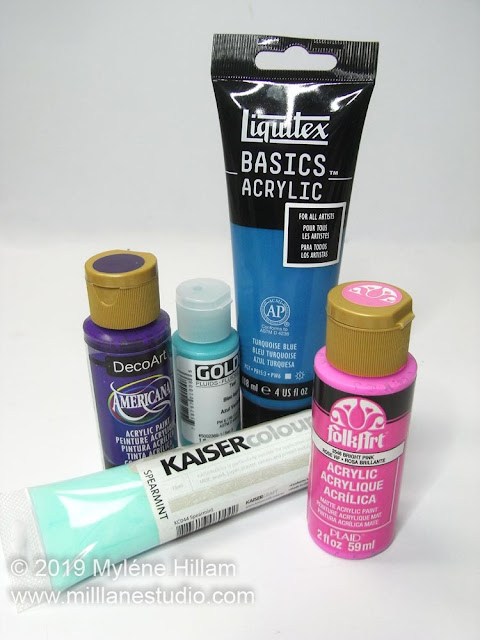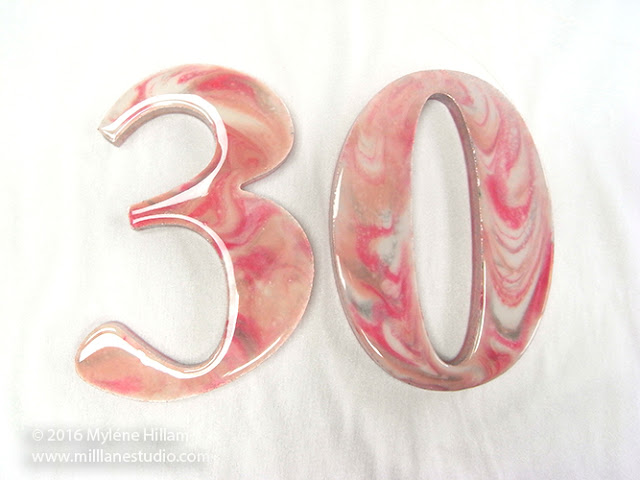As a thank you, I promised to make one specially decorated "30" for the birthday girl to keep as a memento of the occasion.
She left it in my hands to decorate it in any style I wanted but she did stipulate one thing.... that it be in her favourite colour...
PINK!
I knew immediately what I wanted to do - give the numbers a FAUX MARBLE FINISH USING RESIN.
I know I said I was making these in pink, but they turned out so well, that I also made some in purple so you'll notice throughout this tutorial that there are purple ones too!
This faux marble technique looks hard to do...
This faux marble technique looks hard to do...
but I promise you that it is SUPER EASY and gives marble-ous results!
Here's what you'll need:
Before you begin measuring the resin, you'll need to prepare all your pieces of wood. Wood has a cellular nature, so if you apply resin straight onto its surface, it will expel air into the resin. Sometimes it even fluffs up, leaving fibres poking through the surface of the resin.
Here's what you'll need:
- Coating epoxy resin
- Acrylic paint in four coordinating colours. I chose titanium white for the background, light pink as the main colour, and bright pink and silver as my accent colours. For the purple one, I used my favourite shade of purple instead of the pink
- Wooden or MDF numbers - choose large ones 6-8" tall
- Paintbrush
- Disposable brush - you won't be able to re-use this so cheap acid brushes are OK.
- Painter's Pyramids
- 8 oz measuring cup (silicone is easy to clean)
- Disposable plastic cup
- 3 30ml (1 oz) graduated measuring cups
- wooden stir sticks
- Painter's plastic drop sheet (I like this one with its paper backing... it has more substance than one without the paper layer)
- Painter's Tape
- Disposable Nitrile gloves
- Rubbing alcohol in a spray bottle (or a gas lighter) - for popping bubbles
Can you Colour Epoxy Resin with Acrylic Paint?
The short answer is, YES, you can. But...
Not all acrylic paints work well in epoxy resins. Each resin has its own formulation, as does each acrylic paint and they're sometimes not compatible. But the large colour range available makes it worth trying them out.
Before colouring all the resin you've mixed, test your chosen colours in a small amount of resin first. If any of the paints don't mix into the resin properly and you get granules of undissolved pigment through the resin, then make a note (keep a journal of what you've tried). It doesn't necessarily mean that those paints don't work in epoxy, it just means that they didn't work in the brand of epoxy that you used. Keep in mind that those same paints might work marvellously in a different brand of epoxy.
In general, I've found that the more expensive artist quality paints have worked really well in epoxy resin. But I've also had success with some, but not all, of the cheaper craft paint brands.
Prepping the Wood
Cover your workspace with the painter's drop sheet because this is a messy project!Before you begin measuring the resin, you'll need to prepare all your pieces of wood. Wood has a cellular nature, so if you apply resin straight onto its surface, it will expel air into the resin. Sometimes it even fluffs up, leaving fibres poking through the surface of the resin.
You can avoid this by sealing it first with regular craft paint. Choose a colour that will work with the colours you've chosen for the marbling. This base colour will give the marbling colours a little more oomph as well as place a barrier between the wood and the resin so that the wood can't outgas.
Now, trim the tape as close as you can to the edge.
Elevate the numbers on the Painter's Pyramids.
Paint the front and side edges of the numbers and leave them to dry completely, overnight if possible so that there is no moisture left in the paint.
The second step is to tape all the back edges so that any resin that drips down the sides will collect on the tape where you can easily deal with them once the resin has cured.
Tip: Choose a quality tape like Scotch or 3M because with some of the cheaper paper tapes, the resin will penetrate the paper and glue it permanently to the wood.
Cut short strips and overlap them. It's OK to have them extending past the edges.
Now, trim the tape as close as you can to the edge.
Mixing and Colouring the Resin
From here on in, wear your gloves.Measure out the two parts of resin in equal quantities. For numbers of this size, you'll need approximately 90ml (3oz) of mixed resin.
It might seem like a lot of resin for a small project but to achieve the marble finish, you need twice as much resin as you'd normally use.
Mix the two parts together until you don't see any swirls, scraping any unmixed resin off the sides of the cup a couple of times.
Mix the two parts together until you don't see any swirls, scraping any unmixed resin off the sides of the cup a couple of times.
Before adding colour to the resin, make sure you read the note about using acrylic paints in resin at the beginning of the tutorial.Pour 7.5mls (1/4 oz) of mixed resin into a small cup and 15mls (1/2 oz) into each of the other two small cups. Add a small squirt (just a few drops) of colour into each one.
EXPERT TIP:
Only use as much paint as it takes to make the resin opaque. If you overdo the paint, the resin will not cure properly.
Mix the paint into each cup of resin thoroughly.
You can see that the colour in these four pots is only just opaque. You don't want to add any more paint than necessary. But if you're colours aren't quite opaque enough, just add a little more, one drop at a time.
Drizzle the main feature colour across the numbers at an angle.
Use a wooden stir stick to drizzle thin strands of the two highlight colours across the numbers diagonally.
Very lightly draw the acid brush across the surface of the resin randomly. This will open up and soften the marble patterns in the next step.
Now comes the best part - creating the marbling. It's messy.... but fun!
Pick up the numbers and tip them sideways so the colours begin to run into each other and drip off the edge.
See how to clean your cups for re-use in your next project here!
Mix the paint into each cup of resin thoroughly.
You can see that the colour in these four pots is only just opaque. You don't want to add any more paint than necessary. But if you're colours aren't quite opaque enough, just add a little more, one drop at a time.
Creating the Faux Marble Effect
Pour the base colour across the numbers. You want the resin to flow over the sides.Drizzle the main feature colour across the numbers at an angle.
Use a wooden stir stick to drizzle thin strands of the two highlight colours across the numbers diagonally.
Very lightly draw the acid brush across the surface of the resin randomly. This will open up and soften the marble patterns in the next step.
Now comes the best part - creating the marbling. It's messy.... but fun!
Pick up the numbers and tip them sideways so the colours begin to run into each other and drip off the edge.
Then, tilt the number in a different direction to give the marbled pattern more movement.
You can continue tilting the number in any number of directions until you are happy with the look. I only tilted the numbers in two directions. If you don't like the look you've achieved, you can start again by adding more of each of the colours.
Use the paintbrush to wipe away the drips underneath. Use the excess to paint resin onto the sides and underneath.
Use the paintbrush to wipe away the drips underneath. Use the excess to paint resin onto the sides and underneath.
Pop the Surface Bubbles in the Resin
Spritz the surface lightly with rubbing alcohol to pop any bubbles that have surfaced.
If using a gas torch, pass the flame briefly across the surface of the resin to pop any bubbles.
I'm sure you'll agree, this is absolutely marble-ous!

Subscribe to my email list and learn how to resin like an expert.
Removing the Resin Drips and the Tape
If you didn't tape the back of the numbers, you'll need to keep wiping the drips away for a couple of hours. Then set the numbers aside in a dust-free area to cure for 24 hours. The manufacturer's directions tell you how long it will take according to the temperature in your workspace.
Once the resin has completely cured, you can carefully remove the tape and then apply a coat of paint to the back for a really neat finish.
I'm sure you'll agree, this is absolutely marble-ous!
Like this technique? Pin it!
Happy Resining!

Subscribe to my email list and learn how to resin like an expert.
Subscribe to:
Post Comments (Atom)

























This is one of the most professional presentations I’ve seen. The methods and advice not only worked on this project but will greatly assist this neophyte in planned projects.
ReplyDeleteGlad it's been of help to you. Enjoy your journey into the world of resin!
DeleteSo beautyful. Is that epoxy resin ab clear ?
ReplyDeleteThank you :). Yes, it's a clear, 2-part epoxy resin. EnviroTex Lite is a coating resin so you get a nice thick coverage with it.
DeleteLoved your instruction.You answered so many of my questions. can't wait to try this. one Question,how do you clean your resin measuring cups?
DeleteGlad you found the post helpful.
DeleteI have a blog post that will answer your questions about cleaning your resin cups. You'll find it here: https://milllanestudio.blogspot.com/2018/04/how-to-clean-your-resin-mixing-cups.html
Thanks for the educational tips. But details are important. What kind of "rubbing alcohol" did you use and way what concentration? Isopropyl or ethyl alcohol (or something else) and 70% or 90% commonly found in pharmacies? popping has is usually due to carbon dioxide, not heat, so your alcohol application is new to me. The more expensive artists paints (versus student paints) have more and higher quality pigments in them, the most expensive component of the paint, which is why they work better. Metallic colors are usually bronze or mica and each mixes differently. I appreciate the post.
ReplyDeleteRubbing alcohol breaks the surface tension and that's why the bubbles pop. It's just standard isopropyl alcohol (aka rubbing alcohol), nothing special about it. I use 64% and it works well, so you should have success with either 70% or 90%. You'll find that the alcohol will evaporate quickly without leaving a trace.
Delete